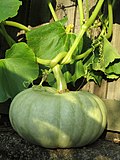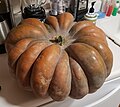| Al Hachi 阿爾哈奇 | Cucurbita moschata | Kashmir | The people of Kashmir dry Al Hachi pumpkins to eat in the winter, when snowfall can isolate the valley. |
 | Big Max | Cucurbita maxima | United States | Big Max can exceed 100 pounds (45 kg) and 20 in (510 mm) in diameter under ideal growing conditions. The variety was hybridized for its size during the early 1960s. Individual fruits are round to slightly flattened. |
 | Calabaza | Cucurbita moschata | Cuba and West Indies | The calabaza is a variety originating in Cuba and the West Indies. It is also cultivated in the Philippines and United States. |
 | Cheese pumpkin | Cucurbita moschata | North America, possibly from an origin in Central America[74] | So-called for its resemblance to a wheel of cheese, this cultivar has been noted for its long storage ability as well as relatively poor culinary characteristics. One of Duchesne's 1786 botanical illustrations depicts a fruit that has been identified with the Cheese Pumpkin. |
 | Connecticut field pumpkin 康乃狄克州田間南瓜 | Cucurbita pepo | North America[13] | Considered to be "one of the oldest pumpkins in existence". Widely used for autumn decorations, either whole or as jack-o'-lanterns. |
| Dickinson pumpkin | Cucurbita moschata | North America | The oblong, ribbed fruits weigh up to 40 pounds and are widely used for canning. Derived from the Kentucky field pumpkin by Elijah Dickinson when he moved to Illinois in 1835. Libby's Select is classified either as a selection from the Dickinson Pumpkin or a selection from the same parent lineage. |
 | Dill's Atlantic Giant | Cucurbita maxima | North America | Dill's Atlantic Giant was bred by Howard Dill from sources including the Mammoth Pumpkin variety.[83][84] The variety were patented in 1979, who then went on to set the giant pumpkin in 1980 with a 459 lb (208 kg) record. |
 | Galeux d'Eysines | Cucurbita maxima | France | The Galeux d'Eysines is mentioned in the Vilmorin-Andrieux vegetable catalogue Les Plantes Potagères in 1883. It is noted for peanut-sized growths on its skin, caused by a buildup of sugar. Its name may have originally been Brodé galeux d'Eysines, translating to embroidered with scabs, from Eysines. Immature pumpkins can be etched with words or designs that become warts as it matures. Galeux d'Eysines was reportedly brought to the United States in 1996 from the Foire aux Potirons pumpkin festival in Tranzault, France, by author Amy Goldman. |
 | Japanese pie pumpkin | Cucurbita argyrosperma | Pennsylvania | The Japanese pie pumpkin is so-called because its seeds become crazed, resembling to Americans the appearance of Chinese characters or Japanese kanji. This variety was introduced by Samuel Wilson of Pennsylvania in 1884. |
 | Jarrahdale pumpkin | Cucurbita maxima | Australia | A variety with a blue-gray skin, named after the Western Australian town of Jarrahdale. The Jarrahdale closely resembles the Queensland Blue. It cuts easily, and has orange, sweet-tasting flesh. |
| Jonathan pumpkin[13][90] | Cucurbita argyrosperma | | Available commercially as early as 1891 from Livingston Seed. The name Jonathan may originate as a form of melioration against the character of Brother Jonathan which was sometimes used as mocking personification of the United States by satirists in Europe. Brother Jonathan was also used within the United States either as characterizing the epitome of thrift and industriousness, or an unsophisticated bumpkin. |
 | Kabocha 日本南瓜 (栗子南瓜) | Cucurbita maxima | Japan | Kabocha is the general Japanese word for winter squashes. In English, the term "kabocha" is usually used for a green-skinned cultivar derived from buttercup squash. |
| Kentucky field pumpkin | Cucurbita moschata | Cuba, Mexico, or the United States | Kentucky field pumpkin is among the pumpkin cultivars grown specifically for jack-o-lantern carving. It has been classified as part of a group of Cucurbita moschata cultivars historically grown by the Seminole 塞米諾爾南瓜 people of the United States southeast, as well as by farmers in Louisiana, Alabama, and Mississippi. Similar cultivars were identified in Cuba as well as coastal and southern Mexico. |
 | Musquée de Provence, Moscata di Provenza or fairytale pumpkin | Cucurbita moschata | France | A large pumpkin from France with sweet, fragrant, deep-orange flesh often sold by the slice due to its size. |
 | Seminole pumpkin | Cucurbita moschata | Florida | A landrace originally cultivated by the Seminole people of what is now Florida. Naturalists in the 18th century recorded Seminole pumpkins growing with their vines hanging from trees. |
 | Styrian pumpkin 史蒂利亞南瓜 | Cucurbita pepo | Styria | Styrian pumpkins (Cucurbita pepo subsp. pepo var. styriaca or var. oleifera) have hull-less seeds, which are used in Austria and Slovenia as part of a pumpkin seed oil industry that presses their roasted seeds.[99][100] |
 | Sugar pumpkin 糖南瓜 | Cucurbita pepo | North America | The sugar pumpkin is one of the earliest varieties of pumpkin documented by European colonists upon arrival in North America. It has sweeter flesh than the similar but larger Connecticut Field pumpkin from which sugar pumpkins may have been selected. |






![[可切割] 蜜本南瓜 (1500克 原隻) - 有機 / 雲南有機認證蔬菜 / 每斤 (600克)](https://shoplineimg.com/5f327a399420db0014fe8377/637c90d29b37a8002e02b9f0/375x.jpeg?)
![[可切割] 蜜本南瓜 (1500克 原隻) - 有機 / 雲南有機認證蔬菜 / 每斤 (600克)](https://shoplineimg.com/5f327a399420db0014fe8377/63016eceecf13f0029bdc1cc/375x.png?)
















![[外賣] 林昌記南瓜魚湯 (P2 P3) / 林昌記 / 100%香港製造 / 每份 (250/500毫升)](https://shoplineimg.com/5f327a399420db0014fe8377/674c78c922bf41000e1c3d85/375x.png?)
![[外賣] 林昌記南瓜魚湯 (P2 P3) / 林昌記 / 100%香港製造 / 每份 (250/500毫升)](https://shoplineimg.com/5f327a399420db0014fe8377/674bee06deac3c000b03569d/375x.jpg?)




























